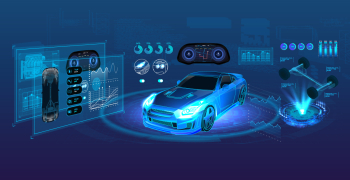We often rush to adopt the latest and shiniest tech stacks and tools in the market. While this can be exciting, it does not always make our lives easier and may even introduce unforeseen complexities. For instance, leveraging Redux for React applications can be an overkill, especially when React’s own state management does a wonderful job for moderately complex applications.
I have often wondered if we could adopt minimalism in approach to our development tools and infrastructure, especially for in-vehicle software development for Software-Defined Vehicles (SDVs), where ensuring simplicity, efficiency, flexibility, and customization is vital.
For instance, let us look at Automotive Grade Linux (AGL). AGL is a collaborative open-source project that brings together automakers, suppliers, and technology companies to accelerate the development of a fully open software stack for connected cars. By using AGL, developers can leverage a standardized platform that supports rapid development and integration of new features.
What we need to reckon with here is that the biggest reason for going open source is community support. While leveraging open-source solutions, you are not just using software but rather joining a vibrant community of developers and experts. This collaborative environment fosters innovation and ensures that the software is continuously improved. It is like having a global team of experts collaborating with you, ready to tackle any challenges that come your way.
Scaling toward the Open-Source Future
When it comes to programming languages, choices are aplenty. But the rising star here is Rust, rapidly gaining acceptance in automotive software development due to its strong focus on memory safety and performance. It eliminates entire classes of bugs related to memory management, which are critical in safety-sensitive automotive applications. Leveraging an ability to interface seamlessly with existing C and C++ codebases for a gradual transition, Rust also makes it easier to adopt modifications without the need for a complete rewrite.
For automotive diagnostics, ODX (Open Diagnostic Data Exchange) and OTX (Open Test Sequence Exchange) have emerged as crucial standards. Together, they enable standardized, efficient communication and testing across different vehicle systems, enhancing the development, production, and service processes. This aligns well with the minimalist and open-source principles, promoting simplicity and interoperability.
Along with core features comes application development. Using containerization for application deployment is a powerful tool. There are several open-source containerization technologies which are suitable for in-vehicle deployment, including, Podman, Containerd, LXD, K3s, etc. Containerization also helps in the standardization of development, testing and deployment tools across models and hardware platforms.
Eclipse SDV (Software-Defined Vehicle) is another excellent example. It provides open-sourced, modular software components and frameworks that are fully integrated into the developer experience with a high degree of automation and virtualization.
Understanding the Eclipse Stack
The Eclipse SDV stack is designed with modularity in mind, which means you can tailor it to fit your specific needs for the automotive domain. Think of it as having a custom toolkit where you can easily select the components that work best for your vehicle.
A major advantage here, as expected, is significant cost savings. As an open-source solution, Eclipse eliminate the need for expensive licensing fees, giving you access to high-quality software without the hefty price tag. This can be a game-changer, especially for projects with tight budgets.
Integration is also a breeze with the Eclipse SDV stack. It supports various standards and protocols, ensuring seamless integration with different hardware and software systems within the vehicle. The Eclipse SDV stack also comes with a rich set of tools and frameworks that can significantly speed up development, helping enable new features and updates to market faster – a major win in the fast-paced automotive industry.
With exacting standards for quality management, security, and safety, the stack also plays a crucial role across automotive applications, enabling a more adaptable, efficient, and secure in-vehicle system.
Leveraging Infrastructure as Code for Driving the SDV Revolution
Infrastructure as Code (IaC) enables developers to ensure that environments are consistent and reproducible. Tools like Terraform and Ansible allow for the automation of infrastructure setup and management, reducing the risk of human error and ensuring that development, testing, and production environments are identical.
For in-vehicle software, simulation, and virtual testing is invaluable. Using cloud-based environments, developers can effortlessly simulate various scenarios and test their software in a controlled setting. This approach helps speed up the development process and ensures high-quality software. Hyperscalers like AWS, Google and Microsoft can be leveraged to scale up and scale down simulation and virtual environments for faster and cheaper development.
Imagine you are building a robust server-side application as part of the SDV Cloud. The minimalist approach encourages you to focus on core functionality, ensuring your code is clear, efficient, and free of unnecessary complexity. This aligns perfectly with the use of open-source tools, which are often designed to be modular and highly efficient. Let us look at some tools to illustrate this.
Docker, for instance, allows you to containerize your applications, ensuring they run consistently across different environments. This aligns with the minimalist principle of efficiency, as Docker containers are lightweight and reduce overhead.
Another great tool is NGINX, a high-performance web server that can also be used as a reverse proxy, load balancer, and HTTP cache. NGINX is known for its simplicity and efficiency, making it perfect for quick, hassle-free deployment.
For version control, GitHub and GitLab are indispensable. These platforms help manage your codebase efficiently and foster collaboration within the open source community.
Kubernetes is another powerful tool that fits well with minimalist principles. It automates the deployment, scaling, and management of containerized applications, allowing you to focus on writing clean, efficient code without worrying about the underlying infrastructure.
And finally, consider Visual Studio Code (VS Code), an open source code editor that supports debugging, syntax highlighting, intelligent code completion, and more. Its lightweight nature and extensive plugin ecosystem make it a favorite among developers who value simplicity and efficiency.
Charting the Future with Open-Source Minimalism
By integrating open-source tools into your server-side development process, you can embrace the minimalist software development ideology, creating applications that are not only powerful and efficient but also easy to maintain and extend. The approach ensures high-quality software that meets user needs without unnecessary complexities.
Minimalism in software development is, therefore, not just a technical philosophy but a mindset that prioritizes meaningful innovation over unnecessary complication. Embracing open-source tools and minimalism in SDV development can eliminate expensive licensing fees, reducing overall costs. The flexibility of the open-source stack further allows for easy customization and integration, ensuring that the software can adapt to evolving needs. Maintenance becomes more straightforward with a modular approach, reducing downtime and improving efficiency. And finally, the absence of vendor lock-in provides freedom to choose the best tools and solutions, with community support helping foster closer and more effective collaboration and continuous improvement, with access to the latest innovations and best practices toward driving the SDV future.




